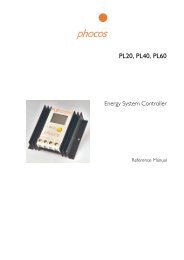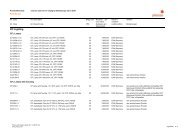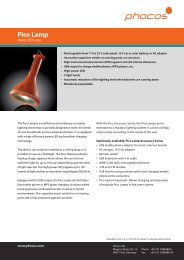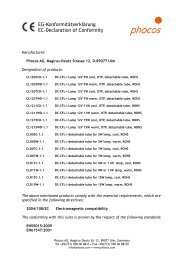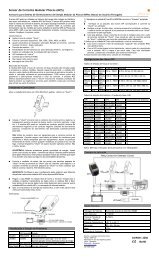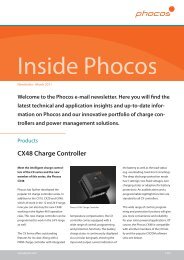Phocos CIS-CU - Phocos.com
Phocos CIS-CU - Phocos.com
Phocos CIS-CU - Phocos.com
Create successful ePaper yourself
Turn your PDF publications into a flip-book with our unique Google optimized e-Paper software.
DESehr geehrter Kunde,Wir bedanken uns für den Kauf eines <strong>Phocos</strong> Produktes. Vor Benutzunglesen Sie sich bitte die Anleitung sorgfältig und gründlich durch.DieseAnleitung gibt Ihnen Hinweise zur Installation, zum Betrieb, zurProgrammierung und zur Fehlerbehebung. Lesen Sie sie im eigenenInteresse sorgfältig durch.GebrauchsanweisungKonfigurieren des <strong>CIS</strong> Ladereglers via Infra rot VerbindungKlare und einfache BedienoberflächeBedienoberfläche: LEDs, Dreh- und Schibeschalter, TastenStromversorgung: 2 X AA Batterien2
3DE
DE Benutzung des <strong>CU</strong>Die Konfiguration des <strong>CIS</strong> mit dem <strong>CU</strong> ist sehr einfach.Setzen Sie alle Schalter in die gewünschte Einstellung ---> Drücken Sie die"Send" Taste ---> und warten Sie auf die Rückmeldung.Buzzer-RückmeldungNach ÜbertragungNach ÜbertragungNach Drücken der Test TasteNach dem DrückenProgrammier FehlerProgrammierung ErfolgreichTest Befehl Übertragung<strong>CU</strong> Batterien LeerLED-Rückmeldung"Error (Fehler)" nach "Senden""Error" während "Senden""Error""OK" nach "Senden""Senden"Programmier FehlerBatterie SchwachBatterie LeerProgrammierung ErfolgreichÜbertragungTastenTest Last(en) an für 2 Minuten 1Send Übertragung aller Einstellungen 21) Wenn durch drücken der Taste ein Lastabwurf (LVD / SOC,Überstrom) verursacht werden sollte, wird die Last abgeschalten.2) Bei dieser Aktion werden alle Einstellungen an den <strong>CIS</strong> Kontrollergesendet. Stellen Sie sicher, dass Sie nur jeweils einen <strong>CIS</strong> Kontrollerprogrammieren.4
Last-Steuerfunktion (Doppellast-Laderegler)DELast 1 Last 2Zeitreferenz 1 2 Stunden basierend auf Mitte derNacht oder Abend- undMorgendämmerungAbend (h) 5 8 1-15 StundenMorgen (h) 6 9 1-14 Stunden und D2D Abend- bisMorgendämmerungs ModusSOC LVD (V) 7 10 Ladezustand (SOC) undSpannungsgesteuert (LVD)1) Spannungsgesteuert (LVD): Lastabwurf bei einer fixen Spannungzwischen 11.0/22.0 V und 11.9/23.8 V (Schritt 0.1 V).2) Ladezustandsgesteuert (SOC): Lastabwurf bei11.00 V/22.00 V bis 11.70 V/23.40 V (SOC1),11.12 V/22.24 V bis 11.76 V/23.52 V (SOC2),11.25 V/22.50 V bis 11.83 V/23.63 V (SOC3),11.38 V/22.72 V bis 11.89 V/23.78 V (SOC4),11.51 V/23.02 V bis 11.96 V/23.92 V (SOC5),11.64 V/23.28 V bis 12.02 V/24.04 V (SOC6).Abend/Morgen ModusStunden basieren auf die Mitte der Nacht (Schiebeschalter nachoben).Stunden basierend auf Abend- und Morgendämmerung(Schiebeschalter nach unten).5
DE Abend- bis Morgendämmerungs ModusD2D bedeutet Abend- bis Morgendämmerungs Modus(Drehschalter 6 und 9) Standard Controller Modus (Morgen h und Abend h OFF)Schaltet Morgen- und Abendtunden aus und aktiviert den StandardKontroller Modus. Lasten sind immer an, wenn kein Lastabwurf(LVD/SOC, Überstrom) eintritt.Last-Steuerfunktion (Einzellast-Laderegler)Last DimmenZeitreferenz 1 2 Stunden basierend auf der Mitte derNacht oder Abend- undMorgendämmerungAbend (h) 5 8 1-15 StundenMorgen (h) 6 9 1-14 Stunden und D2D Abend- bisMorgendämmerungs ModusSOC LVD (V) 7 10 Ladezustand (SOC) undSpannungsgesteuert (LVD)Dimmen (%) N/A 11 Dimmwert (0-100%, Schritt 10%)Abend/Morgen Modus1. Stunden basierend auf Mitte der Nacht(Schiebeschalter nach oben)6
2. Stunden basierend auf Abend- und Morgendämmerung(Schiebeschalter nach unten)DE3. Last Abend/Morgen, Dimmen D2D (Abend- bis Morgendämmerung)(Drehschalter 9).4. Last Abend/Morgen, Dimmen Off 1 Modus.1)Schaltet Sie Morgen- und Abendstunden aus um denStandardregler-Modus zu aktivieren. Lasten sind immer an, wenn keinLastabwurf (LVD/SOC, Überstrom) eintritt.7
DE Abend- bis Morgendämmerungs Modus1. Last D2D Abend- bis Morgendämmerungs-Modus, DimmenAbend/Morgen-Modus2. Last D2D Abend- bis Morgendämmerungs Modus, Dimmen D2DAbend- bis Morgendämmerungs-Modus3. Last D2D Abend-bis Morgendämmerungs-Modus,Dimmen OFF-Modus3. Standardladeregler-Modus (Morgen h and Abend h OFF)Schalteten Sie Morgen- und Abendstunden aus um denStandardregler-Modus zu aktivieren. Lasten sind immer an wenn keineLastunterbrechung (LVD/SOC, Überstrom) eintritt.8
1. Last Standard, Dimmen Abend/Morgen ModusDE2. Last Standard, Dimmen D2D Abend- bis Morgendämmerungs-Modus3. Last Standard, Dimmen Off-ModusAnmerkung: Dimmen kann abhängig vom Batterie SOC sein.Setzen Sie einen Wert durch Drehung des Schalters 10; falls dieBatteriespannung unter diesen Wert fällt wird die Dimmen Funktionaktiviert.Nachterkennungs-FunktionNachterkennung (V) (Drehschalter 12) wird Benutzt um dieNachterkennungsspannung festzulegen. Für den Kontroller startet dieAbenddämmerung, wenn die Spannung auf diesen Wert fällt.Morgendämmerung startet, wenn der Spannung wieder bis zurTagerkennungsspannung steigt. Diese entspricht der Nachterkennung+1,5V. Um den geeigneten Wert zu finden empfehlen wir, dieLeerlaufspannung der Solaranlage zu messen, wenn die Dämmerung denWert erreicht hat, an dem der Laderegler den beginn der Nachterkennen soll.Anmerkung:Schiebeschalter 4 ist reserviert für zukünftige Anwendungen.9
DE <strong>CU</strong> ReichweiteDie <strong>CU</strong> kann den <strong>CIS</strong> Regler in einer Reichweite von bis zu 10mEntfernung ansteuern. Vorrausgesetzt Sie sind so positioniert, dasdie <strong>CU</strong> dirket auf den <strong>CIS</strong> Regler ausgerichtet ist.Wenn Sie mehr als einen <strong>CIS</strong> Regler konfigurieren möchten,vergewissern Sie sich, dass Sie auch nur einen <strong>CIS</strong> Regler auf einmalin Ihrer Nähe konfigurieren. Um sicher zu sein, behalten Sie einenkurzen Abstand zum Regler und eine große Entfernung zu denanderen Reglern, wie unten dargestellt.Beispiel-Konfigurationen <strong>CIS</strong>05/10/20-2L (Doppel Last)Last 1: Doppelter Zeitschalter (Last bis 4 h zur Mitte der Nacht, ab 3 hnach Mitte der Nacht), LVD: 11.4 V.Last 2: Standard Kontroller, LVD: 11.9 V.Batterie Typ: Flüssigsäure, Nachterkennung: 5.5 V.Last Steuer-Funktion:10
Nacht- und Tagerkennungs-Spannung (Leerlaufspannung):DEAbend (h)Last 1(Drehschalter 5)Abend (h)Last 2(Drehschalter 8)Morgen (h)Last 1(Drehschalter 6)Morgen (h)Last 2(Drehschalter 9)SOC LVD (V)Last 1(Drehschalter 7)SOC LVD (V)Last 2(Drehschalter 10)Nachterkennung (V)Last 1 und Last 2(Drehschalter 12)Dimmen (%)(Drehschalter 11)--ZeitreferenzLast 1ZeitreferenzLast 2Nach obenNach obenZeitreferenz(Schiebeschalter 2)--11
DE <strong>CIS</strong>05/10/20 (Einfache Last, Kein Dimmen)1. Doppelter Zeitschalter (Last bei 4 h nach der Abenddämmerung,3 h vor der Morgendämmerung), LVD: 11.4 V, Kein Dimmen, GelBatterie, Nachterkennung: 5.5 V.Last Steuer-Funktion:Nacht- und Tagerkennungs Spannung (Leerlaufspannung):12
Abend (h)Last(Drehschalter 5)Abend (h)Dimmen(Drehschalter 8)DEMorgen (h)Last(Drehschalter 6)Morgen (h)Dimmen(Drehschalter 9)SOC LVD (V)Last(Drehschalter 7)SOC LVD (V)Dimmen(Drehschalter 10)--Nachterkennung(V) Last undDimmen(Drehschalter 12)Dimmen (%)(Drehschalter 11)Zeitreferenz Last Nach unten Zeitreferenz(Schiebeschalter2)ZeitreferenzDimmenNach unten--<strong>CIS</strong>05/10/20 (Einfache Last, Dimmen)Doppelter Zeitschalter (Last bei 4 h nach der Abenddämmerung, 3 hvor der Morgendämmerung), LVD: 11.4 V, Dimmen (Abend h 2,Morgen h 1, Dimmen LVD 11.9 V),Gel Batterie, Dimmwert:60%,Nachterkennung: 5.5 V.Anmerkung: Dimmen wird auch aktiviert falls die Batterie unter 11.9Vfällt.Last Steuer- Funktion:13
DE Nacht- und Tagerkennungs-Spannung (Leerlaufspannung):Abend (h)Last(Drehschalter 5)Abend (h)Dimmen(Drehschalter 8)Morgen (h)Last(Drehschalter 6)Morgen (h)Dimmen(Drehschalter 9)SOC LVD (V)Last(Drehschalter 7)SOC LVD (V)Dimmen(Drehschalter 10)Dimmen (%)(Drehschalter 11)Nachterkennung (V)Last und Dimmen(Drehschalter 12)ZeitreferenzLastZeitreferenzDimmenNach untenNach untenZeitreferenz(Schiebeschalter 2)Nach unten14
Technische DatenDELeistungsaufnahmeLaufzeitAbmessungenGewichtGeräteschutzklasseUmgebungstemperatur-BereichMax. 100 mABis zu 20 k Programmierungen mit2000mAh Batterien70 mm x 135 mm x 24 mm150 g (ohne Batterien)IP22-40 bis +60 °CÄnderungen Vorbehalten. Version: 20101130Hergestellt in einem der folgenden Länder:Deutschland - China - Bolivien - Indien<strong>Phocos</strong> AG - Deutschland www.phocos.<strong>com</strong>ISO9001RoHS15
EN<strong>Phocos</strong> <strong>CIS</strong>-<strong>CU</strong>Control UnitUser Manual16
Dear Client,Thank you very much for buying a <strong>Phocos</strong> product. With your new <strong>CIS</strong>-<strong>CU</strong>remote controller you own a state-of-the art device which was developedaccording to the latest available technical standards.This manual gives important re<strong>com</strong>mendations for installing, using andprogramming as so on. Read it carefully in your own interest please.General Product DescriptionENConfigures <strong>CIS</strong> charge controllers via infra-red data linkSimple and clear configuration interfaceUser Interface: LEDs, rotary switches, toggle switches, buttonsPower supply: 2 X AA battery17
EN18
How to use <strong>CU</strong>To configure <strong>CIS</strong> by <strong>CU</strong> is very easy.Set all switches to desired settings ---> Press "Send" button ---> Waitfor response.Buzzer ResponseENAfter TransmittingAfter TransmittingAfter Pressing Test ButtonAfter Pressing ButtonProgramming ErrorProgramming SuccessfulTest Command Transmitted<strong>CU</strong> Battery EmptyLED Response"Error" after "Transmit""Error" while "Transmit""Error""OK" after "Transmit""Transmit"Programing ErrorLow BatteryBattery EmptyProgramming SuccessfulTransmittingPush ButtonsTest Load(s) on for 2 minutes 1Send Transmit all Settings 21) If pressing the button causes a load disconnect event (LVD/SOC, overcurrent) the load will be switched off.2) This action will send all the settings to the <strong>CIS</strong> controller. Be sure toprogram only one <strong>CIS</strong> at the same time.19
Load Control Function (Dual Load Controller)ENLoad 1 Load 2Timer Reference 1 2 Hours base on middle of nightor dusk and dawnEvening (h) 5 8 1-15 hoursMorning (h) 6 9 1-14 hours and D2D(Dusk toDawn) modeSOC LVD (V) 7 10 State of charge (SOC) andVoltage controlled (LVD)1) Voltage controlled (LVD):Disconnect at a fixed voltage between 11.0/22.0V and 11.9/23.8V (Step0.1V).2) State of charge (SOC) controlled:Disconnect at 11.00 V/22.00 V to 11.70 V/23.40 V (SOC1), 11.12 V/22.24V to 11.76 V/23.52 V (SOC2), 11.25 V/22.50 V to 11.83 V/23.63 V (SOC3),11.38 V/22.72 V to 11.89 V/23.78 V (SOC4), 11.51 V/23.02 V to 11.96V/23.92 V (SOC5), 11.64 V/23.28 V to 12.02 V/24.04V (SOC6).Evening/Morning modesHours based on middle of night (toggle switch up).Hours based on Dusk & Dawn (toggle switch down).20
Dusk to Dawn modeD2D means Dusk to Dawn mode. (Rotary switch 6 and 9)ENStandard Controller Mode (Morning h and Evening h OFF)Switch off both morning and evening hours to active standardcontroller mode. Loads are always on if no load disconnect event(LVD/SOC, over current) happens.Load Control Function (Single Load Controller)LoadDimmingTimer Reference 1 2 Hours base on middle ofnight or dusk and dawnEvening (h) 5 8 1-15 hoursMorning (h) 6 9 1-14 hours and D2D (Duskto Dawn) modeSOC LVD (V) 7 10 State of charge (SOC) andVoltage controlled (LVD)Dimming (%) N/A 11 Dimming values (0-100%,step 10%)21
Evening/Morning modesEN 1. Hours based on middle of night (toggle switch up).2. Hours based on Dusk & Dawn (toggle switch down).3. Load Evening/Morning, Dimming D2D (Dusk to Dawn) (rotary switch 9).4. Load Evening/Morning, Dimming Off 1 Mode.1)Switch off both morning and evening hours to active Dimming offmode. Loads are always on if no load disconnect event happens(LVD/SOC, over current) .22
Dusk to Dawn mode1. Load D2D mode, Dimming Evening/Morning modeEN2. Load D2D mode, Dimming D2D mode3. Load D2D mode, Dimming OFF Mode23
Standard Controller Mode (Morning h and Evening h OFF)ENSwitch off both morning and evening hours to active standardcontroller mode. Loads are always on if no load disconnect event(LVD/SOC, over current) happens.1. Load Standard, Dimming Evening/Morning mode2. Load Standard, Dimming D2D mode3. Load Standard, Dimming Off modeNOTE: Dimming can also be activated based on battery SOC/LVD. Set avalue using Rotary Switch 10; if the battery voltage falls below thevalue, the dimming function is activated.24
Night Detect FunctionNight detect (V)(Rotary switch 12) is used to set the Night DetectVoltage. For the controller, dusk starts when the panel voltage fallsto this value. Dawn starts when voltage rises to the Day DetectVoltage, which equals Night Detect + 1.5 V. To find the appropriatevalue, we re<strong>com</strong>mend measuring the solar array open circuit voltageat the time when twilight has reached the level when the controllershould assume night has begun.<strong>CIS</strong> factory default is 8V.NOTE: Toggle Switch 4 is reserved for future use.<strong>CU</strong> Working RangeThe <strong>CU</strong> can operate at up to 10 m distance from the <strong>CIS</strong> providedyou are positioned and <strong>CU</strong> is pointed directly in front of the <strong>CIS</strong> unit.If you would like to configure more than one <strong>CIS</strong>, be sure to havevisual proximity/contact to only one <strong>CIS</strong> unit at a time. To assure this,keep a minimum angle and distance to the others as shown below.EN25
Example ConfigurationsEN <strong>CIS</strong>05/10/20-2L (Dual Load)Load 1: Dual Timer (Load on till 4 hours to Mid of Night, from 3 hours afterMid of Night), LVD: 11.4 V.Load 2: Standard controller, LVD: 11.9V.Battery type: Flooded, night detect: 5.5 V.Load Control Function:Night and Day detect voltage (Solar open circuit voltage):26
Evening (h)Load 1(Rotary Switch 5)Evening (h)Load 2(Rotary Switch 8)ENMorning (h)Load 1(Rotary Switch 6)Morning (h)Load 2(Rotary Switch 9)SOC LVD (V)Load 1(Rotary Switch 7)SOC LVD (V)Load 2(Rotary Switch 10)Night Detect (V)Load 1 and Load 2(Rotary Switch 12)Dimming (%)(Rotary Switch 11)Don't CareTimer ReferenceLoad 1(Toggle Switch 1)Battery Type(Toggle Switch 3)UPUPTimer ReferenceLoad 2(Toggle Switch 2)Don't Care<strong>CIS</strong>05/10/20 (Single Load, No Dimming)1. Dual Timer (Load on for 4 hours after dusk, 3 hours before dawn), LVD: 11.4V, No Dimming, Sealed Battery, night detect: 5.5 V.Load Control Function:27
Night and Day detect voltage (Solar open circuit voltage):ENEvening (h)Load(Rotary Switch 5)Evening (h)Dimming(Rotary Switch 8)Morning (h)Load(Rotary Switch 6)Morning (h)Dimming(Rotary Switch 9)SOC LVD (V)Load(Rotary Switch 7)SOC LVD (V)Dimming(Rotary Switch 10)Don't CareNight Detect (V)Load and Dimming(Rotary Switch 12)Dimming (%)(Rotary Switch 11)Timer ReferenceLoad(Toggle Switch 1)Battery Type(Toggle Switch 3)DownDownTimer ReferenceDimming(Toggle Switch 2)Don't Care<strong>CIS</strong>05/10/20 (Single Load, Dimming)Dual Timer (Load on for 4 hours after dusk, 3 hours before dawn), LVD:11.4 V, Dimming (Evening h 2, Morning h 1, Dimming LVD 11.9 V), SealedBattery, Dimming value: 60%, night detect: 5.5 V.NOTE: Dimming will also be activated if battery falls below 11.9V.28
Load Control Function:ENNight and Day detect voltage (Solar open circuit voltage):Evening (h)Load(Rotary Switch 5)Evening (h)Dimming(Rotary Switch 8)Morning (h)Load(Rotary Switch 6)Morning (h)Dimming(Rotary Switch 9)SOC LVD (V)Load(Rotary Switch 7)SOC LVD (V)Dimming(Rotary Switch 10)Night Detect (V)Load and Dimming(Rotary Switch 12)Dimming (%)(Rotary Switch 11)Timer ReferenceLoad(Toggle Switch 1)Battery Type(Toggle Switch 3)DownDownTimer ReferenceDimming(Toggle Switch 2)Down29
Technical DataENPower ConsumptionRun-timeDimensionsWeightCase ProtectionMax. 100 mAUp to 20 k programmings with2000mAh batteries70 mm x 135 mm x 24 mm150 g (without batteries)IP22Ambient Temperature Range -40 to +60 °CSubject to change without notice.Version: 20101130Made in one of the following countries:Germany - China - Bolivia - India<strong>Phocos</strong> AG - Germanywww.phocos.<strong>com</strong>ISO9001RoHS30
ES<strong>Phocos</strong> <strong>CIS</strong>-<strong>CU</strong>Unidad de ControlManual de instrucciones (Español)31
ESEstimado Usuario,Muchas gracias por adquirir un producto de <strong>Phocos</strong>. Por favor, antesde utilizar este producto lea las instrucciones detenidamente y al<strong>com</strong>pleto.Descripción general del productoConfigurar controladores de carga <strong>CIS</strong> mediante conexión porinfrarrojoInterfaz de usuario simple y claraInterfaz de usuario: LEDs, interruptores giratorios,interruptoresdeslizantes, botonesSuministro de energía: 2 pilas AA32
33ES
ESModo de empleo del <strong>CU</strong>La configuración del <strong>CIS</strong> mediante el <strong>CU</strong> es muy fácil.Coloque todos los interruptores en los ajustes deseados ---> Aprieteel botón de envío “Send” ---> Espere la reacción.Reacción de zumbidoDespués de transmitirDespués de transmitirDespués de apretar el botón de pruebaDespués de apretar el botónError de programaciónProgramación exitosaTransmitido el <strong>com</strong>andode pruebaPilas del <strong>CU</strong> vacíasReacción de LED"Error" después de la "transmisión""Error" durante la "transmisión""Error""OK" después de la "transmisión""Transmitir"Error de programaciónPilas casi vacíasPilas vacíasProgramación exitosaTransmisiónBotonesTest (Prueba) Carga(s) encendida(s) por 2 minutos 1Send (Envío) Transmisión de todos los ajustes 21)Si al apretar el botón se desconecta la carga(LVD/SOC,sobrecorriente), se apagará la carga.2)Esta acción enviará todos los ajustes al controlador <strong>CIS</strong>. Asegúrese deprogramar un solo <strong>CIS</strong> cada vez.34
Función de control de carga(controlador de carga doble)Referencia detiempoCarga 1 Carga 21 2 Horas basadas en el medio de lanoche o anochecer y amanecerTarde (h) 5 8 1-15 horasMañana (h) 6 9 1-14 horas y D2D modo delanochecer al amanecerSOC LVD (V) 7 10 Estado de la carga (SOC) ytensión controlada (LVD)ES1)Tensión controlada (LVD):Se desconecta a una tensión fija entre11.0/22.0V y 11.9/23.8V (Salto 0.1V).2)Estado de la carga (SOC) controlado:Se desconecta en11.00 V/22.00 V hasta 11.70 V/23.40 V(SOC1),11.12 V/22.24 V hasta 11.76 V/23.52 V(SOC2),11.25 V/22.50 V hasta 11.83 V/23.63 V(SOC3),11.38 V/22.72 V hasta 11.89 V/23.78 V(SOC4),11.51 V/23.02 V hasta 11.96 V/23.92 V(SOC5),11.64 V/23.28 V hasta 12.02 V/24.04 V(SOC6).Modo tarde/mañanaHoras basadas en el medio de la noche (interruptor deslizante haciaarriba).Horas basadas en anochecer y amanecer (interruptor deslizante haciaabajo).35
ES Modo del anochecer al amanecerD2D significa modo del anochecer al amanecer. (Interruptoresgiratorios 6 y 9)Modo controlador estándar (horas de la mañana y de la tardeapagadas)Apague las horas de la mañana y de la tarde para activar el modocontrolador estándar. Las cargas están siempre encendidas si no ocurreuna desconexión de la carga (LVD/SOC, sobrecorriente).Función de control de carga (controlador de carga simple)Referenciade tiempoCargaAtenuaciónde luz1 2 Horas basadas en el medio dela noche o anochecer yamanecerTarde (h) 5 8 1-15 horasMañana (h) 6 9 1-14 horas y modo D2D (delanochecer al amanecer)SOC LVD (V) 7 10 Estado de la carga (SOC) ytensión controlada (LVD)Atenuaciónde luz (%)No 11 Valores de atenuación de luzdisponible(0-100%, salto 10%) Modos de tarde/mañana1. Horas basadas en el medio de la noche (interruptor deslizante haciaarriba).36
2. Horas basadas en anochecer y amanecer (interruptor deslizante haciaabajo).ES3. Carga tarde/mañana, atenuación de luz D2D (del anochecer alamanecer) (interruptor giratorio 9).4. Carga tarde/mañana, modo de apagado (OFF 1 ) de atenuación deluz.1)Apague las horas de la mañana y de la tarde para activar el modode apagado de atenuación de luz. Las cargas están siempreencendidas si no ocurre una desconexión de la carga (LVD/SOC,sobrecorriente).37
ES Modo del anochecer al amanecer1. Modo de carga D2D del anochecer al amanecer, modo deatenuación de luz tarde/mañana2. Modo de carga D2D del anochecer al amanecer, modo deatenuación de luz D2D del anochecer al amanecer3. Modo de carga D2D del anochecer al amanecer, modo de apagado deatenuación de luz38
Modo de controlador estándar (horas de la mañana y la tardeapagadas)Apague las horas de la mañana y la tarde para activar el modo decontrolador estándar. Las cargas están siempre encendidas si noocurre una desconexión de la carga (LVD/SOC, sobrecorriente).ES1. Carga estándar, modo de atenuación de luz tarde/mañana2. Carga estándar, modo de atenuación de luz D2D del anochecer alamanecer3. Carga estándar, modo de apagado de atenuación de luzNOTA: La atenuación de luz puede ser activada también mediante el SOC(estado de la carga) de las pilas. Determine un valor usando elinterruptor giratorio 10; y si la tensión de las pilas cae por debajo dedicho valor, se activará la función de atenuación de luz.39
ESFunción de detección de la nocheLa detección de la noche (V) (interruptor giratorio 12) se emplea parafijar la tensión de detección de la noche. Para el controlador el anochecer<strong>com</strong>ienza cuando la tensión del panel cae hasta este valor. Elamanecer <strong>com</strong>ienza cuando la tensión sube hasta la tensión dedetección del día, la cual concuerda con la de detección de la noche +1.5 V. Para determinar el valor apropiado, re<strong>com</strong>endamos medir la tensiónde la instalación solar en circuito abierto en el momento en que elcrepúsculo haya alcanzado el nivel que, para el controlador, será elindicador de que ha <strong>com</strong>enzado la noche. El ajuste de fábrica del <strong>CIS</strong>es de 8V.NOTA: El interruptor deslizante 4 está reservado para usos futuros.Alcance del <strong>CU</strong>El <strong>CU</strong> puede funcionar a una distancia del <strong>CIS</strong> de hasta 10 m,siempre y cuando usted esté bien situado y el <strong>CU</strong> apunte de formadirecta hacia el controlador <strong>CIS</strong>.Si usted desea configurar más de un <strong>CIS</strong>, asegúrese de tenerproximidad/contacto visual con un solo controlador <strong>CIS</strong> cada vez.Para garantizarlo, guarde un ángulo y distancia mínimos de los otros<strong>CIS</strong> <strong>com</strong>o se demuestra debajo.40
Ejemplo de configuraciones <strong>CIS</strong>05/10/20-2L (Carga doble)Carga 1: Temporizador doble (Carga hasta 4 horas hasta lamedianoche, 3 horas después de la medianoche), LVD: 11.4 V.Carga 2: Controlador estándar, LVD: 11.9 V.Tipo de batería: Inundada, detección de noche: 5.5 V.Función de control de carga:ESTensión de detección de la noche y el día (tensión solar en circuitoabierto):41
Tarde (h)(interruptorgiratorio 5)Tarde (h)(interruptor giratorio8)ESMañana (h)(interruptorgiratorio 6)Mañana (h)(interruptor giratorio9)SOC LVD (V)(interruptorgiratorio 7)SOC LVD (V)(interruptor giratorio10)Detección de lanoche (V)(interruptorgiratorio 12)Atenuación de luz (%)(interruptor giratorio11)Da igualReferencia detiempo(interruptordeslizante 1)La batería(interruptordeslizante 3)Hacia arribaHacia arribaReferencia detiempo(interruptordeslizante 2)Da igual <strong>CIS</strong>05/10/20 (Carga simple, sin atenuación de luz)1. Temporizador doble (Carga 4 horas después del anochecer, 3 horas antesdel amanecer), LVD: 11.4 V, sin atenuación, batería de gel, detección de lanoche: 5.5 V.Función de control de carga:42
Tensión de detección de la noche y el día (tensión solar en circuitoabierto):ESTarde (h)(interruptorgiratorio 5)Tarde (h)(interruptorgiratorio 8)Mañana (h)(interruptorgiratorio 6)Mañana (h)(interruptorgiratorio 9)SOC LVD (V)(interruptorgiratorio 7)SOC LVD (V)(interruptorgiratorio 10)Da igualDetección de lanoche (V)(interruptorgiratorio 12)Atenuación de luz(%)(interruptorgiratorio 11)Referencia detiempo(interruptordeslizante 1)La batería(interruptordeslizante 3)Hacia abajoHacia abajoReferencia detiempo(interruptordeslizante 2)Da igual43
ES <strong>CIS</strong>05/10/20 (Carga simple, atenuación de luz)Temporizador doble (Carga 4 horas después del anochecer, 3 horas antesdel amanecer), LVD: 11.4 V, atenuación de luz (tarde h 2, mañana h 1,atenuación de luz LVD 11.9 V), batería de gel, valor de atenuación de luz:60%, detección de noche: 5.5 V.NOTA: La atenuación también se activará si la batería está por debajo delos 11.9V.Función de control de carga:Tensión de detección de la noche y el día (tensión solar en circuitoabierto):44
Tarde (h)(interruptorrotatorio 5)Mañana (h)(interruptorrotatorio 6)Tarde (h)(interruptorrotatorio 8)Mañana (h)(interruptorrotatorio 9)ESSOC LVD (V)(interruptorrotatorio 7)SOC LVD (V)(interruptorrotatorio 10)Atenuación de luz(%)(interruptorrotatorio 11)Detección de lanoche (V)(interruptorrotatorio 12)Referencia detiempo(interruptordeslizante 1)La batería(interruptordeslizante 3)Hacia abajoHacia abajoReferencia detiempo(interruptordeslizante 2)Hacia abajoDatos técnicosConsumo de energíamáx. 100 mADuración Programaciones de hasta 20k con pilas de 2000mAhDimensionesPesoProtección de la caja70 mm x 135 mm x 24 mm150 g (sin pilas)IP22Límite de temperatura ambiente -40 to +60 °CSujeto a cambios sin previo aviso. Versión: 20101130Hecho en uno de los siguientes países:Alemania - China - Bolivia - La India<strong>Phocos</strong> AG - Alemania www.phocos.<strong>com</strong>ISO9001RoHS45
FR<strong>Phocos</strong> <strong>CIS</strong>-<strong>CU</strong>FernsteuerungGuide de l'Utilisateur46
Cher Client,Nous vous remercions pour votre achat d'un de nos produits <strong>Phocos</strong>.Veuillez lire, avec attention, toutes les instructions avant d'utiliser leproduit.Description Générale du Produit Permet de configurer des régulateurs de charge <strong>CIS</strong> via unéchange de données infrarouge Panneau de <strong>com</strong>mande simple et clair Interface de l’utilisateur : DEL, <strong>com</strong>mutateurs rotatifs,interrupteurs à bascule, boutons Alimentation : 2 piles AAFR47
FR48
Utilisation de la télé<strong>com</strong>mandeLa configuration du régulateur <strong>CIS</strong> se fait très facilement via latélé<strong>com</strong>mande.Configurer les boutons <strong>com</strong>me désiré ---> Appuyer sur « Envoi » --->Attendre la réponse.Réponse du vibreur sonoreFRAprès la transmissionAprès la transmissionAprès avoir appuyé sur lebouton testle boutonRéponse DELAprès avoir appuyé surErreur de programmationProgrammation réussieTransmission de la demandede testPiles de la télé<strong>com</strong>mandevides« Erreur » après « transmission » Erreur de programmation« Erreur » pendant « Transmission » Piles faibles« Erreur » Piles vides« OK » après « Transmission » Programmation réussie« Transmission » Transmission en coursBoutons poussoirsTest Charge(s) activée(s) pendant 2 minutes 1Send Transmission de tous les paramètres. 21) Si en appuyant sur la touche vous déclenchez un délestage (LVD/SOC,surintensité), la charge est mise hors tension.2) Cette action envoie tous les paramètres au contrôleur <strong>CIS</strong>. Assurez-vousde ne programmer qu’un seul régulateur <strong>CIS</strong> à la fois.49
Fonction <strong>com</strong>mandant la charge (régulateur doublecharge)FRRéférenceminuterieCharge 1 Charge 21 2 heures calculées en fonction dumilieu de la nuit ou ducrépuscule et de l’aubeSoirée (h) 5 8 1-15 heuresMatin (h) 6 9 1-14 heures et mode D2D (aubeà crépuscule)SOC LVD(V)7 10 État de charge (SOC) etdéclenchement de la tension(LVD)1) Déclenchement de la tension (LVD) :Déconnecté à une tension fixe <strong>com</strong>prise entre 11,0 V / 22,0 V et 11,9V / 23,9 V (par palier de 0,1 V).2) Commande de l’état de charge (SOC) : Déconnecté à11,00 V/22,00 V jusqu'à 11,70 V/23,40 V(SOC1),11,12 V/22,24 V jusqu'à 11,76 V/23,52 V(SOC2),11,25 V/22,50 V jusqu'à 11,83 V/23,63 V(SOC3),11,38 V/22,72 V jusqu'à 11,89 V/23,78 V(SOC4),11,51 V/23,02 V jusqu'à 11,96 V/23,92 V(SOC5),11,64 V/23,28 V jusqu'à 12,02 V/24,04 V(SOC6).Modes soirée/matinHeures calculées en fonction du milieu de la nuit (mettrel’interrupteur à bascule vers le haut).50
Heures calculées en fonction du crépuscule et de l’aube(interrupteur vers le bas).FR Mode crépuscule/aubeD2D signifie mode crépuscule à l’aube (Commutateurs rotatifs 6 et9) Mode de <strong>com</strong>mande standard (H matin et H soirée hors service)Désactiver les heures de matin et de soirée pour avoir accès aumode de <strong>com</strong>mande standard. Les charges restent toujours soustension si aucun incident ne survient (LVD/SOC, surintensité).Fonction <strong>com</strong>mandant la charge (régulateur chargeSIMPLE)RéférenceminuterieCharge Variation1 2 heures calculées en fonction dumilieu de la nuit ou ducrépuscule et de l’aubeSoirée (h) 5 8 1-15 heuresMatin (h) 6 9 1-14 heures et mode D2D (aubeà crépuscule)SOC LVD (V) 7 10 État de charge (SOC) etdéclenchement de la tension(LVD)Variation (%) N/A 11 Valeurs DE VARIATION (0-100 %,PAR PALIER DE 10 %)51
Modes soirée/matin1. Heures calculées en fonction du milieu de la nuit (mettre l’interrupteur àbascule vers le haut).FR2. Heures calculées en fonction du crépuscule et de l’aube (interrupteur àbascule vers le bas).3. Charge Soirée/Matin, Variation D2D (crépuscule à L’aube) (<strong>com</strong>mutateur rotatif 9).52
4. Charge Soirée/Matin, Variation Hors service 1 .FR1) Désactiver les heures du matin et de soirée pour mettre le modeVariation hors service. Les charges restent toujours sous tension siaucun incident ne survient (LVD/SOC, surintensité).Mode crépuscule/aube1. 1. Charge mode D2D, mode Variation Soirée/Matin2. Charge mode D2D, mode Variation D2D53
3. Charge mode D2D, mode Variation hors serviceFR Mode de <strong>com</strong>mande standard (H matin et H soirée hors service)Désactiver les heures de matin et de soirée pour avoir accès au modede <strong>com</strong>mande standard. Les charges restent toujours sous tension siaucun incident ne survient (LVD/SOC, surintensité).1. Charge standard, mode Variation Soirée/Matin2. Charge standard, mode Variation D2D3. Charge standard, mode Variation hors serviceRemarque : Il est possible d’activer le mode de variation depuis l’étatde charge (SOC) de la batterie. Définir une valeur à l’aide du<strong>com</strong>mutateur rotatif 10 ; si la tension de la batterie chute en dessousde cette valeur, la fonction de variation s’active.54
Fonction détectant la nuitLa détection de la nuit (V) (<strong>com</strong>mutateur rotatif 12) sert à définir latension du mode Détection Nuit. Pour le régulateur, l’aube<strong>com</strong>mence lorsque la tension du panneau chute et atteint cettevaleur. Le crépuscule démarre lorsque la tension augmente à lavaleur de la Tension de Détection Jour, qui correspond à laDétection Nuit + 1,5 V. Pour connaître la valeur la plus adaptée, nousvous re<strong>com</strong>mandons de mesurer la tension à vide du générateursolaire lorsque le crépuscule a atteint le niveau que le régulateuridentifie <strong>com</strong>me le début de la nuit. Le réglage par défaut durégulateur <strong>CIS</strong> est 8 V.Remarque : L’interrupteur à bascule 4 est réservé à un usageultérieur.Portée de la télé<strong>com</strong>mandeLa télé<strong>com</strong>mande peut fonctionner à une distance pouvantatteindre 10 m, sous réserve que vous vous trouviez bien en face durégulateur <strong>CIS</strong> et que la télé<strong>com</strong>mande soit parfaitement orientéeface à ce dernier.Si vous souhaitez paramétrer plus d’un régulateur <strong>CIS</strong>, assurez-vousde rester à proximité de l’appareil que vous êtes en train deconfigurer avant de passer à un autre. Il suffit pour cela de conserverun angle et une distance minimum par rapport aux autres, <strong>com</strong>meillustré ci-après.FR55
FRExemples de configuration <strong>CIS</strong>05/10/20-2L (Double charge)Charge 1 : minuterie (charge activée jusqu’à 4 heures en fonction dumilieu de la nuit, au moins 3 heures après le milieu de la nuit), LVD :11,4 V.Charge 2 : contrôleur standard, LVD : 11,9 V.Type de batterie : sans entretien, détection nuit : ,5.5 V.Fonction <strong>com</strong>mandant la charge :56
Tension de détection de la nuit et du jour (tension à vide solaire) :FRSoirée (h)(<strong>com</strong>mutateurrotatif 5)Soirée (h)(<strong>com</strong>mutateurrotatif 8)Matin (h)(<strong>com</strong>mutateurrotatif 6)Matin (h)(<strong>com</strong>mutateurrotatif 9)SOC LVD (V)(<strong>com</strong>mutateurrotatif 7)SOC LVD (V)(<strong>com</strong>mutateurrotatif 10)Détection Nuit (V)(<strong>com</strong>mutateurrotatif 12)Variation (%)(<strong>com</strong>mutateurrotatif 11)--Référenceminuterie(interrupteur àbascule 1)Batterie le type(interrupteur àbascule 3)VERS LEHAUTVERS LEHAUTRéférenceminuterie(interrupteur àbascule 2)--57
<strong>CIS</strong>05/10/20 (charge simple, pas de variation)1. Double minuterie (charge activée pendant 4 heures après l’aube,3 heures avant le crépuscule), LVD : 11,4 V, pas de variation, batteriesans entretien, détection nuit : 5,5 V.Fonction <strong>com</strong>mandant la charge :FRTension de détection de la nuit et du jour (tension à vide solaire) :58
Soirée (h)(<strong>com</strong>mutateurrotatif 5)Soirée (h)(<strong>com</strong>mutateurrotatif 8)Matin (h)(<strong>com</strong>mutateurrotatif 6)Matin (h)(<strong>com</strong>mutateurrotatif 9)FRSOC LVD (V)(<strong>com</strong>mutateurrotatif 7)SOC LVD (V)(<strong>com</strong>mutateurrotatif 10)--Détection Nuit(V)(<strong>com</strong>mutateurrotatif 12)Variation (%)(<strong>com</strong>mutateurrotatif 11)Référenceminuterie(interrupteur àbascule 1)Batterie le type(interrupteur àbascule 3)Vers le basVers le basRéférenceminuterie(interrupteur àbascule 2)-- <strong>CIS</strong>05/10/20 (charge simple, avec variation)Double minuterie (charge activée pendant 4 heures après l’aube, 3heures avant le crépuscule), LVD : 11.4 V, variation (soirée 2 h, matin1 h, variation LVD 11,9 V), batterie sans entretien, valeur devariation : 60 %, détection nuit : 5,5 V.Remarque : Le mode variation s’active également si la batterie chute endessous de 11,9 V.Fonction <strong>com</strong>mandant la charge :59
Tension de détection de la nuit et du jour (tension à vide solaire) :FRSoirée (h)(<strong>com</strong>mutateurrotatif 5)Soirée (h)(<strong>com</strong>mutateurrotatif 8)Matin (h)(<strong>com</strong>mutateurrotatif 6)Matin (h)(<strong>com</strong>mutateurrotatif 9)SOC LVD (V)(<strong>com</strong>mutateurrotatif 7)SOC LVD (V)(<strong>com</strong>mutateurrotatif 10)Détection Nuit(V)(<strong>com</strong>mutateurrotatif 12)Variation (%)(<strong>com</strong>mutateurrotatif 11)Référenceminuterie(interrupteur àbascule 1)Batterie le type(interrupteur àbascule 3)Vers le basVers le baRéférenceminuterie(interrupteur àbascule 2)Vers le bas60
Caractéristiques techniquesConsommationTemporisationDimensionsPoidsProtection du boîtierPlage de températuresambiantes100 mA max.programmable jusqu’à 20 k avecles piles de 2.000 mAh70 mm x 135 mm x 24 mm150 g (sans les piles)IP22- 40°C à + 60°CFRSusceptible d'être modifié sans préavis.Version : 20101130Fabriqué dans l'un des pays suivants :Allemagne - Chine - Bolivie - Inde<strong>Phocos</strong> AG - Allemagne www.phocos.<strong>com</strong>ISO9001RoHS61
PO<strong>Phocos</strong> <strong>CIS</strong>-<strong>CU</strong>Unidade de controleInstruções de uso62
Descrição Geral do ProdutoConfiguração dos controles de carga <strong>CIS</strong> através de um canal dedados infravermelhoInterface de manejo simples e claroInterface do usuário: LEDs, <strong>com</strong>utadores rotativos, <strong>com</strong>utadores <strong>com</strong>ação de cotovelo, teclasFonte de alimentação: 2 X bateria AAPO63
PO64
Como utilizar uma UC (Unidade de controle)É muito fácil configurar o CSI através da UC.Para efetuar os ajustes desejados nos <strong>com</strong>utadores ---> Premer atecla Enviar "Send" ---> Aguardar reação.Reação da cigarraApós a transmissãoApós a transmissãoErro de programaçãoProgramação bem-sucedidaApós premer a tecla de testes Transmissão do Comando deTestesApós Premer TeclaBateria da UC descarregadaPOReação LED"Erro" após "Enviar""Erro" Durante "Envio""Erro""OK" após "Enviar""Enviar"Erro de programaçãoBateria FracaBateria DescarregadaProgramação bem-sucedidaEnviandoTeclasTeste Carga(s) ligada(s) por 2 minutos 1Send (Enviar) Envio de todos os ajustes 21) Se ao premer a tecla ocorrer um evento de desconexão de carga(LVD - diretiva baixa tensão/SOC – estado da carga, sobrecorrente), acarga será desligada.2) Esta ação irá enviar todos os ajustes ao controlador <strong>CIS</strong>. Assegure-se deprogramar somente um <strong>CIS</strong> de cada vez.65
Função de Controle de Carga (Controlador de CargaDupla)POReferênciatemporalCarga 1 Carga 21 2 Baseada nas horas da metade danoite, ou crepúsculo e amanhecerNoite (h) 5 8 1-15 horasManhã (h) 6 9 1-14 horas e modo D2D(crepúsculo ao amanhecer)SOC LVD (V) 7 10 Estado da carga (SOC) econtrolado pela tensão (LVD)1) Tensão controlada (LVD):Rejeição de carga a uma tensão fixada entre 11.0/22.0V e 11.9/23.8V(Passo 0.1V).2) Estado de carga (SOC) controlado:Rejeição de carga em 11.00 V/22.00 V até 11.70/23.40 V (SOC1), 11.12V/22.24 V até 11.76/23.52 V(SOC2), 11.25 V/22.50 V até 11.83 V/23.63 V(SOC3), 11.38 V/22.72 V até 11.89 V /23.78 V (SOC4), 11.51 V/23.02 V até11.96 V/23.92 V (SOC5), 11.64 V/23.28 V até 12.02 V/24.04 V (SOC6).Modo noturno/matinalBaseado nas horas da metade da noite (<strong>com</strong>utador <strong>com</strong> ação de cotovelopara cima)Baseado nas horas do Crepúsculo & Amanhecer (<strong>com</strong>utador <strong>com</strong> açãode cotovelo para baixo).66
Modo crepúsculo ao amanhecerD2D quer dizer modo Crepúsculo ao Amanhecer. (Comutadorrotativo 6 e 9)PO Modo de Controle Padrão (h matinais e h noturnas DESLIGADO)Desligar tanto as horas matinais quanto noturnas para ativar omodo de controle padrão. As cargas estarão sempre ligadas se nãohouver uma rejeição de carga (LVD - diretiva baixa tensão/SOC –estado da carga, sobrecorrente).Função de Controle de Carga (Controlador de CargaÚnica)ReferênciatemporalCargaRedução daintensidade daluz1 2 Baseada nas horas dametade da noite, oucrepúsculo e amanhecerNoite (h) 5 8 1-15 horasManhã (h) 6 9 1-14 horas e modo D2D(crepúsculo ao amanhecer)SOC LVD (V) 7 10 Estado da carga (SOC) econtrolado pela tensão(LVD)Redução da Não seintensidade da aplicaluz (%)11 Valores de redução daintensidade da luz (0-100%,passo 10%)67
Modo noturno/matinal1. Baseado nas horas da metade da noite (<strong>com</strong>utador <strong>com</strong> ação decotovelo para cima)PO2. Baseado nas horas do Crepúsculo & Amanhecer (<strong>com</strong>utador <strong>com</strong> açãode cotovelo para baixo).3. Carga noturna/matinal, redução da intensidade da luz D2D (Crepúsculo aoAmanhecer) (<strong>com</strong>utador rotativo 9).68
4. Carga noturna/matinal, redução da intensidade da luz modoDesligado 1 .PO1)Desligar tanto as horas matinais quanto noturnas para ativar omodo de redução da intensidade da luz. As cargas estarão sempreligadas se não houver uma rejeição de carga (LVD - diretiva baixatensão/SOC – estado da carga, sobrecorrente). Modo Crepúsculo ao Amanhecer1. Carga modo D2D, modo de redução da intensidade da luznoite/manhã2. Carga modo D2D, redução da intensidade da luz do modo D2D69
3. Carga modo D2D, modo redução da intensidade da luz DESLIGADOPO Modo de Controle Padrão (h matinais e h noturnas DESLIGADO)Desligar tanto as horas matinais quanto noturnas para ativar omodo de controle padrão. As cargas estarão sempre ligadas se nãohouver uma rejeição de carga (LVD - diretiva baixa tensão/SOC –estado da carga, sobrecorrente).1. Carga modo padrão, redução da intensidade da luz noturna/matinal2. Carga modo padrão, redução da intensidade da luz modo D2D3. Carga modo padrão, modo redução da intensidade da luzdesligadoObservação: A redução da intensidade da luz pode ser ativada <strong>com</strong>base no estado da carga da bateria. Ajuste um valor através do<strong>com</strong>utador rotativo 10; se a tensão da bateria cair abaixo do valor, afunção de redução da intensidade da luz será ativada.70
Função de Detecção da NoiteA detecção da noite (V) (<strong>com</strong>utador rotatório 12) é usada paraajustar a tensão da detecção da noite. Para o controlador, ocrepúsculo inicia quando a tensão do painel cai a este valor. Oamanhecer <strong>com</strong>eça quando a tensão sobe até a Tensão de DetecçãoDiurna, que é igual à Detecção Noturna + 1.5 V. Para encontrar ovalor apropriado, re<strong>com</strong>endamos a medição da tensão de circuitoaberto do arranjo solar ao mesmo tempo em que o crepúsculo tenhaatingido o nível no qual o controlador suponha que a noite tenha<strong>com</strong>eçado. O valor <strong>CIS</strong> predefinido de fábrica é 8V.Observação: O <strong>com</strong>utador <strong>com</strong> ação de cotovelo 4 está reservadopara uso futuro.Intervalo de trabalho da UCA UC pode operar em até 10 m de distância do <strong>CIS</strong> contanto quevocê esteja posicionado e a UC esteja sendo apontada diretamentepara a parte frontal da unidade <strong>CIS</strong>.Para configurar mais de um CSI, assegure-se que tem umaproximidade/contato visual somente <strong>com</strong> uma unidade <strong>CIS</strong> a cadavez. Para garantir isso, mantenha um ângulo mínimo além dadistância mostrada abaixo.PO71
Exemplos de Configuração <strong>CIS</strong>05/10/20-2L (Carga Dupla)Carga 1: Minuteria dupla (carga ligada até 4 horas para a metade danoite, a partir de 3 horas a partir da metade da noite), LVD: 11.4 V.Carga 2: controlador padrão, LVD: 11.9V.Tipo de bateria: Úmida, detecção da noite: 5.5 V.Função de Controle de Carga:POTensão de Detecção Noite e Dia (tensão solar de circuito aberto):72
Noite (h)(Comutadorrotativo 5)Noite (h)(Comutador rotativo8)Manhã (h)(Comutador rotativo6)Manhã (h)(Comutadorrotativo 9)POSOC LVD (V)(Comutadorrotativo 7)SOC LVD (V)(Comutador rotativo10)Detecção Noturna(V)(Comutador rotativo12)Referênciatemporal(Comutador <strong>com</strong>ação de cotovelo1)Tipo de bateria(Comutador <strong>com</strong>ação de cotovelo3)Para cimaPara cimaRedução da Não importaintensidade da luz(%)(Comutador rotativo11)Referência Não importatemporal(Comutador <strong>com</strong>ação de cotovelo 2) <strong>CIS</strong>05/10/20 (Carga única, sem redução da intensidade da luz)1. Minuteria dupla (carga ligada por 4 horas após crepúsculo, 3 horas antesdo amanhecer), LVD 11.4 V, sem redução da intensidade da luz, bateriaselada, detecção da noite: 5.5 V.Função de Controle de Carga:73
Tensão de Detecção Noite e Dia (tensão solar de circuito aberto):PONoite (h)(Comutadorrotativo 5)Noite (h)(Comutador rotativo8)Manhã (h)(Comutadorrotativo 6)Manhã (h)(Comutadorrotativo 9)SOC LVD (V)(Comutadorrotativo 7)SOC LVD (V) Não importa(Comutador rotativo10)Detecção Noturna(V)(Comutadorrotativo 12)Referênciatemporal(Comutador <strong>com</strong>ação de cotovelo1)Tipo de bateria(Comutador <strong>com</strong>ação de cotovelo3)Para baixoPara baixoRedução daintensidade da luz(%)(Comutador rotativo11)Referência Não importatemporal(Comutador <strong>com</strong>ação de cotovelo 2)74
<strong>CIS</strong>05/10/20 (Carga única, redução da intensidade da luz)Minuteria dupla (carga ligada por 4 horas após crepúsculo, 3 horas antesdo amanhecer), LVD 11.4 V, redução da intensidade da luz (noite h 2,manhã h 1, redução da intensidade da luz LVD 11.9 V), bateria selada,valor de redução da intensidade da luz: 60%, detecção da noite: 5.5 V.Observação: A redução da intensidade da luz também será ativada se abateria ficar abaixo de 11.9V.Função de Controle de Carga:POTensão de Detecção Noite e Dia (tensão solar de circuito aberto):75
Noite (h)(Comutadorrotativo 5)Noite (h)(Comutador rotativo8)POManhã (h)(Comutadorrotativo 6)Manhã (h)(Comutadorrotativo 9)SOC LVD (V)(Comutadorrotativo 7)SOC LVD (V)(Comutador rotativo10)Detecção Noturna(V)(Comutadorrotativo 12)Referência Para baixotemporal(Comutador <strong>com</strong>ação de cotovelo1)Tipo de bateria Para baixo(Comutador <strong>com</strong>ação de cotovelo3)Redução daintensidade da luz(%)(Comutador rotativo11)Referência Para baixotemporal(Comutador <strong>com</strong>ação de cotovelo 2)76
Dados técnicosConsumo de energiaTempo de execuçãoDimensõesPesoProteção da caixaIntervalo da temperaturaambienteMáx. 100 mAProgramações de até 20 k <strong>com</strong>baterias 2000mAh70 mm x 135 mm x 24 mm150 g (sem baterias)IP22-40 a +60 °CPOSujeito a modificações sem aviso prévio. Versão: 20101130Fabricado em um dos seguintes países:Alemanha - China - Bolívia – Índia<strong>Phocos</strong> AG - Alemanha www.phocos.<strong>com</strong>ISO9001:2000RoHS77
CH<strong>Phocos</strong> <strong>CIS</strong>-<strong>CU</strong>遥 控 器用 户 说 明 书78
亲 爱 的 用 户 :非 常 感 谢 您 选 择 <strong>Phocos</strong> 产 品 。 新 一 代 的 <strong>CIS</strong>-<strong>CU</strong> 遥 控 器 , 是 一 款根 据 最 新 的 技 术 标 准 开 发 的 , 代 表 最 新 工 业 技 术 发 展 水 平 的 产 品 。此 产 品 说 明 书 提 供 一 些 与 控 制 器 有 关 的 重 要 建 议 , 包 括 安 装 、 使用 、 编 程 等 。 使 用 产 品 前 请 仔 细 阅 读 此 说 明 书 。产 品 描 述设 置 <strong>CIS</strong> 系 列 控 制 器 的 专 用 红 外 线 遥 控 器界 面 设 计 简 单 清 晰 易 懂用 户 界 面 包 括 : LEDs, 旋 转 开 关 , 拨 码 开 关 , 按 键电 源 : 2 X AA 电 池CH79
CH80
<strong>CU</strong> 使 用 方 法通 过 <strong>CU</strong> 遥 控 器 可 以 很 方 便 的 设 置 <strong>CIS</strong> 控 制 器 。把 所 用 的 开 关 拨 到 合 适 的 位 置 ---> 按 "Send" 键 ---> 等 待 响 应 。蜂 鸣 器 响 应“Transmit” 灯 亮 后“Transmit” 灯 亮 后按 “Test” 键 后按 键 后LED 响 应"Transmit" 灯 亮 后 "Error" 灯 亮"Transmit" 和 "Error" 同 时 亮"Error" 灯 亮"Transmit" 灯 亮 后 "OK" 灯 亮"Transmit" 灯 亮按 键 功 能设 置 失 败设 置 成 功测 试 命 令 发 送 成 功<strong>CU</strong> 电 池 没 电设 置 失 败电 池 电 量 低电 池 没 电设 置 成 功正 在 发 送 设 置 到 <strong>CIS</strong> 控 制 器CHTest 测 试 功 能 , 打 开 负 载 2 分 钟 1Send 发 送 所 有 设 置 21) 如 果 按 编 程 按 钮 打 开 负 载 后 , 导 致 系 统 进 入 LVD( 放 电 保 护 )、过 流 保 护 等 状 态 , 负 载 会 自 动 关 闭 。 当 系 统 处 于 LVD 状 态 时 , 测试 功 能 不 可 用 。2) 按 “Send” 键 会 发 送 所 有 设 置 到 <strong>CIS</strong> 控 制 器 。 请 确 定 同 时 只 设 置 一台 <strong>CIS</strong> 控 制 器 。81
负 载 控 制 功 能 ( 双 负 载 <strong>CIS</strong> 控 制 器 )CH遥 控 器 上 标 识 负 载 1 负 载 2Timer Reference 1 2 设 置 时 间 基 于 午 夜 或 黄 昏 和 凌 晨Evening (h) 5 8 夜 晚 时 间 1-15 小 时Morning (h) 6 9 清 晨 时 间 1-14 小 时 和 D2D( 黄 昏到 凌 晨 ) 模 式SOC LVD (V) 7 10 低 压 保 护 模 式 为 电 池 电 量 控 制(SOC) 或 电 压 控 制 (LVD)1) 蓄 电 池 电 量 方 式 (SOC) 控 制 : 断 开 负 载 在11.00 V/22.00 V 至 11.70/23.40 V(SOC1),11.12 V/22.24 V 至 11.76/23.52 V (SOC2),11.25 V/22.50 V 至 11.83/23.63 V (SOC3),11.38 V/22.72 V 至 11.89/23.78 V (SOC4),11.51 V/23.02 V 至 11.96 / 23.92 V (SOC5),11.64 V/23.28 V 至 12.02/24.04 V (SOC6)。2) 蓄 电 池 电 压 (LVD) 控 制 : 切 断 负 载 电 压 固 定 值 ,11.0 / 22.0 V至 11.9 / 23.8 V。( 精 度 0.1 V)注 释 : 斜 线 前 后 的 数 值 分 别 代 表 在 12 V 和 24 V 系 统 中 的 电 压 值 。夜 晚 / 清 晨 两 段 式设 置 时 间 基 于 午 夜 ( 拨 码 开 关 位 于 上 方 )设 置 时 间 基 于 黄 昏 和 凌 晨 ( 拨 码 开 关 位 于 下 方 )82
黄 昏 到 凌 晨 模 式在 遥 控 器 上 用 D2D 表 示 黄 昏 到 凌 晨 模 式 。( 旋 转 开 关 6 和 9)通 用 控 制 器 模 式 ,Morning (h) 和 Evening (h) 都 在 OFF 位 置Morning (h) 和 Evening (h) 都 在 OFF 的 位 置 时 , 控 制 器 的 负 载 控制 模 式 是 通 用 控 制 器 模 式 。 在 这 种 模 式 下 , 如 果 没 有 负 载 切 断 的事 件 发 生 (LVD/SOC, 过 流 ), 负 载 一 直 有 输 出 。负 载 控 制 功 能 ( 单 负 载 带 功 率 调 节 功 能 的 <strong>CIS</strong> 控 制 器 )CH遥 控 器 上 标 识 负 载 功 率 调 节Timer Reference 1 2 设 置 时 间 基 于 午 夜 或 黄 昏 和 凌 晨Evening (h) 5 8 夜 晚 时 间 1-15 小 时Morning (h) 6 9 清 晨 时 间 1-14 小 时 和 D2D( 黄 昏到 凌 晨 ) 模 式SOC LVD (V) 7 10 低 压 保 护 模 式 为 电 池 电 量 控 制(SOC) 或 电 压 控 制 (LVD)Dimming (%) N/A 11 功 率 调 节 百 分 比 (0-100%, 精 度 10%)夜 晚 / 清 晨 两 段 式1. 设 置 时 间 基 于 午 夜 ( 拨 码 开 关 位 于 上 方 )83
2. 设 置 时 间 基 于 黄 昏 和 凌 晨 ( 拨 码 开 关 位 于 下 方 )CH3. 负 载 夜 晚 / 清 晨 两 段 式 , 功 率 调 节 功 能 黄 昏 到 凌 晨 ( 旋 转 开 关 9).4. 负 载 夜 晚 / 清 晨 两 段 式 , 功 率 调 节 功 能 关 闭11)旋 转 开 关 8 (Evening (h)) 和 9 (Morning (h)) 都 拨 到 OFF 的 位 置 ,关 闭 功 率 调 节 功 能 。84
CH黄 昏 到 凌 晨 模 式1. 负 载 黄 昏 到 凌 晨 模 式 , 功 率 调 节 功 能 夜 晚 / 清 晨 两 段 式2. 负 载 黄 昏 到 凌 晨 模 式 , 功 率 调 节 功 能 黄 昏 到 凌 晨 模 式3. 负 载 黄 昏 到 凌 晨 模 式 , 功 率 调 节 功 能 关 闭 通 用 控 制 器 模 式 (Morning (h) 和 Evening (h) 都 拨 到 OFF )Morning (h) 和 Evening (h) 都 在 OFF 的 位 置 时 , 控 制 器 的 负 载 控制 模 式 是 通 用 控 制 器 模 式 。 在 这 种 模 式 下 , 如 果 没 有 负 载 切 断 的事 件 发 生 (LVD/SOC, 过 流 ), 负 载 一 直 有 输 出 。1. 负 载 通 用 控 制 器 模 式 , 功 率 调 节 功 能 傍 晚 / 清 晨 两 段 式85
2. 负 载 通 用 控 制 器 模 式 , 功 率 调 节 功 能 黄 昏 到 凌 晨 模 式3. 负 载 通 用 控 制 器 模 式 , 功 率 调 节 功 能 关 闭CH注 释 : 功 率 调 节 功 能 也 有 低 压 保 护 功 能 (SOC/LVD), 旋 转 开 关 10 用于 设 置 其 数 值 。 如 果 蓄 电 池 电 压 低 于 设 定 值 , 负 载 调 节 功 能 开 。夜 晚 识 别 功 能<strong>CIS</strong> 控 制 器 通 过 测 量 太 阳 能 电 池 板 的 开 路 电 压 识 别 (Night detect(V) 旋 转 开 关 12)。 当 太 阳 能 电 池 板 电 压 降 到 设 定 值 时 , 控 制 器 认为 傍 晚 开 始 。 太 阳 能 电 池 板 电 压 升 到 白 天 识 别 电 压 时 , 控 制 器 认为 白 天 开 始 , 白 天 识 别 电 压 = 夜 晚 识 别 电 压 +1.5 V。 我 们 推 荐 ,用 户 在 黄 昏 来 临 或 凌 晨 来 临 时 ( 在 用 户 需 要 控 制 器 打 开 或 关 闭 负载 端 时 ), 测 量 太 阳 能 电 池 板 的 开 路 电 压 。 根 据 这 个 数 值 可 以 设置 你 想 要 的 白 天 夜 晚 识 别 电 压 。<strong>CIS</strong> 夜 晚 识 别 电 压 出 厂 设 置 值 为 8 V。注 释 : 拨 码 开 关 4 预 留 , 供 将 来 使 用 。86
CH<strong>CU</strong> 有 效 工 作 范 围<strong>CU</strong> 的 最 长 有 效 距 离 是 10 m。 在 这 种 情 况 下 ,<strong>CU</strong> 方 向 必 须 要 对 准<strong>CIS</strong> 控 制 器 才 能 有 效 传 输 。如 果 在 很 小 的 范 围 内 有 多 个 <strong>CIS</strong> 控 制 器 , 进 行 设 置 时 就 很 有 可 能影 响 到 其 他 控 制 器 。 为 了 避 免 这 一 情 况 的 发 生 , 在 设 置 <strong>CIS</strong> 时 ,请 保 证 其 他 的 控 制 器 在 下 图 所 示 的 范 围 ( 角 度 和 距 离 ) 之 外 。设 置 实 例 <strong>CIS</strong>05/10/20-2L ( 双 负 载 控 制 器 )负 载 1: 夜 晚 / 清 晨 两 段 式 ( 负 载 在 午 夜 前 4 小 时 关 闭 , 午 夜 后 3 小时 打 开 , 直 到 凌 晨 关 闭 ), 低 压 保 护 电 压 (LVD): 11.4 V。负 载 2: 通 用 控 制 器 模 式 , 低 压 保 护 电 压 (LVD): 11.9V。蓄 电 池 类 型 : 液 体 蓄 电 池 , 夜 晚 识 别 电 压 : 8.0 V.负 载 运 行 图 解 :87
夜 晚 和 白 天 识 别 电 压 ( 太 阳 能 端 开 路 电 压 ):CHEvening (h)傍 晚 时 间负 载 1( 旋 转 开 关 5)Morning (h)凌 晨 时 间负 载 1( 旋 转 开 关 6)SOC LVD (V)低 压 保 护负 载 1( 旋 转 开 关 7)Night Detect (V)夜 晚 识 别 电 压负 载 1 和 负 载 2( 旋 转 开 关 12)Timer Reference负 载 1 时 间 基 准( 拨 码 开 关 1)蓄 电 池 类 型( 拨 码 开 关 3)上上Evening (h)傍 晚 时 间负 载 2( 旋 转 开 关 8)Morning (h)凌 晨 时 间负 载 2( 旋 转 开 关 9)SOC LVD (V)低 压 保 护负 载 2( 旋 转 开 关 10)Dimming (%)功 率 调 节( 旋 转 开 关 11)Timer Reference负 载 2 时 间 基 准( 拨 码 开 关 2)不 起 作 用不 起 作 用 <strong>CIS</strong>05/10/20 ( 单 负 载 , 功 率 调 节 功 能 关 )负 载 : 夜 晚 / 清 晨 两 段 式 ( 负 载 旁 晚 开 启 4 小 时 , 凌 晨 开 启 3 小 时 ),低 压 保 护 电 压 (LVD): 11.4 V, 胶 体 蓄 电 池 , 夜 晚 识 别 电 压 : 5.5 V。功 率 调 节 功 能 关 闭 。负 载 运 行 图 解 :88
夜 晚 和 白 天 识 别 电 压 ( 太 阳 能 端 开 路 电 压 ):Evening (h)傍 晚 时 间负 载( 旋 转 开 关 5)Morning (h)凌 晨 时 间负 载( 旋 转 开 关 6)SOC LVD (V)低 压 保 护负 载( 旋 转 开 关 7)Night Detect (V)夜 晚 识 别 电 压负 载 和 功 率 调 节( 旋 转 开 关 12)Evening (h)傍 晚 时 间功 率 调 节 功 能( 旋 转 开 关 8)Morning (h)凌 晨 时 间功 率 调 节 功 能( 旋 转 开 关 9)SOC LVD (V)低 压 保 护功 率 调 节 功 能( 旋 转 开 关 10)Dimming (%)功 率 调 节 功 能( 旋 转 开 关 11)不 起 作 用CHTimer Reference负 载 时 间 基 准( 拨 码 开 关 1)蓄 电 池 类 型( 拨 码 开 关 3)下下Timer Reference功 率 调 节 时 间 基准( 拨 码 开 关 2)不 起 作 用 <strong>CIS</strong>05/10/20 ( 单 负 载 , 功 率 调 节 开 )负 载 : 夜 晚 / 清 晨 两 段 式 ( 负 载 旁 晚 开 启 4 小 时 , 凌 晨 开 启 3 小 时 ),低 压 保 护 电 压 (LVD): 11.4 V, 胶 体 蓄 电 池 , 夜 晚 识 别 电 压 : 5.5 V。功 率 调 节 功 能 : 夜 晚 时 间 2 小 时 , 清 晨 时 间 1 小 时 , 功 率 调 节 低 压 保护 电 压 11.9 V, 功 率 调 节 值 60%。注 释 : 如 果 蓄 电 池 电 压 低 于 11.9 V, 功 率 调 节 功 能 也 会 开 启 。负 载 运 行 图 解 :89
CH夜 晚 和 白 天 识 别 电 压 ( 太 阳 能 端 开 路 电 压 ):CHEvening (h)傍 晚 时 间负 载( 旋 转 开 关 5)Morning (h)凌 晨 时 间负 载( 旋 转 开 关 6)SOC LVD (V)低 压 保 护负 载( 旋 转 开 关 7)Evening (h)傍 晚 时 间功 率 调 节 功 能( 旋 转 开 关 8)Morning (h)凌 晨 时 间功 率 调 节 功 能( 旋 转 开 关 9)SOC LVD (V)低 压 保 护功 率 调 节 功 能( 旋 转 开 关 10)Night Detect (V)夜 晚 识 别 电 压负 载 和 功 率 调 节( 旋 转 开 关 12)Timer Reference负 载 时 间 基 准( 拨 码 开 关 1)蓄 电 池 类 型( 拨 码 开 关 3)下下Dimming (%)功 率 调 节 功 能( 旋 转 开 关 11)Timer Reference功 率 调 节 时 间 基准( 拨 码 开 关 2)下90
技 术 参 数遥 控 器 自 消 耗 电 流 最 大 100 mA2000 mAh 电 池 使 用 寿 命 可 成 功 设 置 高 于 20000 次 <strong>CIS</strong> 控 制 器尺 寸70 mm x 135 mm x 24 mm重 量 150 g ( 除 去 电 池 重 量 )防 护 等 级IP22环 境 温 度 范 围 -40 to +60 °CCH如 有 更 改 , 恕 不 另 行 通 知 。版 本 : 20101130在 以 下 国 家 制 造 :德 国 - 中 国 - 玻 利 维 亚 - 印 度<strong>Phocos</strong> AG – Germanywww.phocos.<strong>com</strong>ISO9001RoHS91







